Ferrit, an emerging technology in the world of robotics and automation, is revolutionizing various industries with its efficiency and precision. Originally developed for military purposes, Ferrit has now found its way into sectors such as manufacturing, healthcare, and logistics, bringing unprecedented capabilities and advancements to the table.
One of the key features of Ferrit is its ability to navigate and operate in complex environments with minimal human intervention. Equipped with sensors and artificial intelligence algorithms, Ferrit can autonomously carry out tasks such as transporting goods in warehouses, performing intricate medical procedures, and even providing security surveillance in sensitive areas.

Unleashing the Power of Ferrit: How This Innovative Technology is Transforming Industries
In the manufacturing industry, Ferrit has proven to be a game-changer in terms of increasing productivity and streamlining operations. By automating tedious and repetitive tasks, Ferrit allows human workers to focus on more value-added activities, leading to higher efficiency and cost savings for companies. Furthermore, Ferrit‘s precision and accuracy make it an ideal candidate for tasks that require delicacy and attention to detail, such as assembling intricate components or inspecting products for defects.
In the healthcare sector, Ferrit has brought about significant improvements in patient care and medical procedures. With its dexterity and precision, Ferrit can assist surgeons in performing complex surgeries with unparalleled accuracy, reducing the risk of human error and enhancing patient outcomes. Additionally, Ferrit can be utilized for tasks such as medication delivery, patient monitoring, and even disinfection of hospital rooms, thereby freeing up healthcare professionals to focus on critical aspects of patient care.

Unleashing the Power of Ferrit: How This Innovative Technology is Transforming Industries
The logistics industry has also witnessed a transformation with the integration of Ferrit into supply chain operations. By automating the movement of goods within warehouses and distribution centers, Ferrit has enabled companies to optimize their inventory management processes, reduce operational costs, and improve order fulfillment efficiency. Moreover, Ferrit’s ability to navigate through narrow aisles and tight spaces makes it ideal for handling tasks that are traditionally challenging for human workers, such as picking and packing items in crowded storage facilities.

Unleashing the Power of Ferrit: How This Innovative Technology is Transforming Industries
Despite its numerous benefits, the implementation of Ferrit does raise concerns about potential job displacement and the future of work. As more tasks become automated through the use of Ferrit and similar technologies, there is a growing need for upskilling and reskilling of the workforce to ensure that they remain relevant in the changing landscape of the labor market. Companies must also consider ethical and safety implications when deploying Ferrit in various settings to prevent unintended consequences and ensure the well-being of both humans and machines.
In conclusion, Ferrit is a groundbreaking technology that is reshaping industries and unlocking new possibilities for innovation and advancement. By harnessing the power of Ferrit, businesses can enhance their operational capabilities, improve efficiency, and drive growth in a rapidly evolving marketplace. As Ferrit continues to evolve and expand its applications, it is crucial for organizations to embrace this transformative technology and leverage its potential to stay ahead of the competition and thrive in the digital age.Tube making machine


